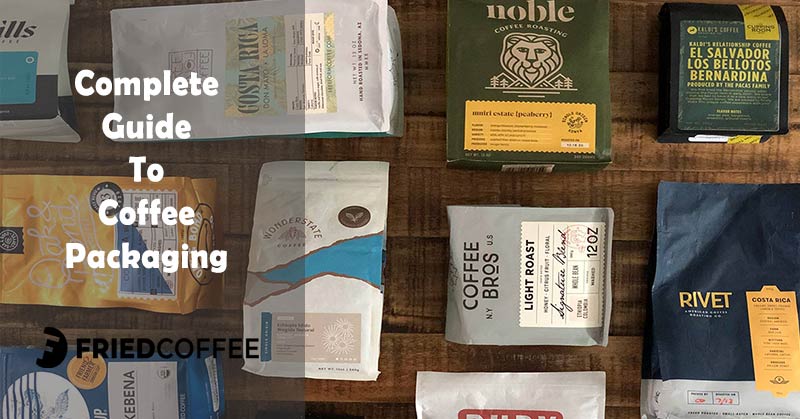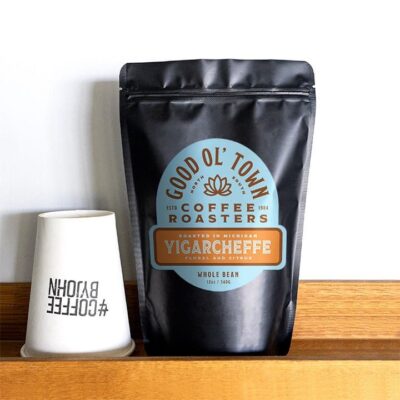
Coffee has been at the heart of culture since its popularization in the Ottoman Empire before it came west and dominated the salon and coffeehouse culture of the European Enlightenment and spread throughout the world. Such a precious commodity must reach its recipients as fresh as possible.
To this day, the way coffee is packaged is a vital decision influencing everything from buyer appeal to the quality of the product inside. The history of coffee packaging has led us to today’s array of different options for stocking, shipping, and selling coffee, so it would do some good to trace that history, discuss those options, and decide which is ultimately the best choice for packaging coffee today.
The Story so Far
Coffee’s history begins in Ethiopia, perhaps as early as 850 AD, with an almost-certainly apocryphal story about a goat and some monks. Stored in jars or barrels at home, the beans made their way in sacks and chests to the Middle East, where coffee house culture became a phenomenon before they became a big hit in the Ottoman Empire. The Europeans adopted a similar culture when they imported coffee, but the Ottomans roasted the beans at the point of origin, then shipped them in non-airtight containers on long sea voyages, which means the stale, bitter coffee Europeans were drinking may well have been intended as a declaration of war.
Around 1710, the French first began sealing ground coffee in linen bags to steep in hot water, and ten years later they first shipped coffee in leather bags sealed with grease or beeswax. In 1790, coffee became popular in the fledgling United States (we had a thing against tea at the time) where it was stored in any pot or jar with a narrow mouth, though customers would take it home in cones of newspaper or whatever was handy. In 1860, Osborn’s Celebrated Prepared Java Coffee became the first pre-ground packaged coffee sold to consumers, though Arbuckle’s Ariosa took Osborn’s place in the market five years later with a machine to fill, weigh, seal, and label roasted coffee in paper packages.
Mechanized coffee packaging led to the Folgers company selling large sacks and drums of beans and grounds to grocery stores before producing the consumer-sized tins of instant coffee that became ubiquitous throughout much of the twentieth century. Italian Francesco Illy invented a way to ship coffee in pressurized containers filled with gas in 1934, and his son Ernesto created the first espresso pods in 1974, presaging the debut of Keurig Cups in 1992.
In 1996, Starbucks went from a neighborhood in Seattle to every neighborhood everywhere, disrupting the coffee industry. Folgers’ big tins gave way to sealed bags of fresh beans and grounds as people sought to bring the cafe experience home.
Packaging Options Galore
Older generations still enjoy their instant coffee, which both tastes better than when Starbucks rose to prominence and is now sold in recyclable plastic tubs with handles. However, the flat-bottom bag is the most popular sort of packaging in stores. An attractive shape lets it stand up vertically while its side gussets help it hold more volume while making it more sustainable and efficient to transport.
Stand-Up Pouches

Stand-up pouches are flat on the bottom. They have a triangular shape and are sealed with a zipper for better freshness, and a slightly broader front allows more room for branding. Less expensive than stand-up bags, with a wide opening making them easy to fill, these pouches have gained market share, especially among small to medium roasters.
Sealed Bags

For larger quantities of coffee, roasters often use more traditional, sturdy, and spacious side-gusset or side-fold bags. These bags stand up vertically as well but are usually sealed by folding the top over and using adhesive tape or tin-ties, creating a situation where coffee bought in bulk goes bad faster.
Flat Pouches

Flat pouches or pillow bags are on the opposite end of the size spectrum — small, flat, often tearaway pouches meant for single use. These containers are printable on all sides, which make for excellent branding, but require aid to stand upright and show off such designs.
Factors to Consider in Coffee Packaging
Coffee roasters have more options than just the shape of their containers (of which the above are just a sampling.) Bags can also have extras that improve the product but add cost. A degassing valve releases the carbon dioxide roasted coffee produces without letting oxygen in, while many packages have multiple sealing options — it is possible to get a side-gusset bag with a zipper or a stand-up pouch with a tin-tie, for example, and the quality of the seal often determines the continued freshness of the coffee. One-use tear notches make flat pouches easy to open, and can be added to other bags on top of the re-sealing method to ensure extra freshness until purchase.
With freshness in the bag (pun intended), the coffee packaging industry of the 21st century is rightfully obsessed with sustainability. Coffee Club created the first fully compostable coffee pod, with similar coffee bags coming to market thanks to Elevate Packaging two years later. At the very least, coffee containers should be fully recyclable or biodegradable, especially if aiming for a younger demographic of discerning coffee drinkers. Such consumers tend to care more about issues like climate change and sustainability, as should any of us who make a living selling the product of a plant dependent on the weather.
Other considerations come into the choice as well, such as the filling process: the bigger a bag’s opening, the easier and more efficient it is to fill with coffee, making the packing process faster and minimizing waste from dropped or spilled products. As mentioned when discussing bag forms, branding is also hugely important, with different containers offering more or less space for interesting branding choices like wraparound designs, color-coded roast indicators, beautiful art, a minimalist aesthetic, and more. Remember that many packages stand up on their own, while others lay flat, so it is important to maximize the impact for consumers noticing the brand on a shelf.
Also Read: Coffee Packaging Design Tips That Sells
What’s Best for You?
Every coffee company has a list of considerations when choosing how they will package and sell their coffee. Of these concerns, the three most important are freshness, sustainability, and branding. Coffee is much less a functional item just meant to wake one up than it used to be and people now require a premium taste.
A zippered bag with a degassing valve will ensure the most freshness but cost more (and of course connoisseurs who want that level of freshness will often have special containers for their beans and throw the packaging out. Or more likely, they will recycle the packaging, since coffee pouches that aren’t at least recyclable will turn off conscientious buyers.
Ultimately, the single most important consideration has to be branding. When he built his packaging machine, John Arbuckle made sure it labeled the parcels. No matter how eco-friendly your packaging or fresh the coffee inside, they must grab consumers’ attention or they’ll languish on shelves, wasting all the effort and money that made for such excellent packaging.
Wrap Up
When looking to ship and sell coffee, always remember that no matter what advancements are made in storage technology, attractive and interesting branding is what makes the difference between a sale and perfectly good beans going bad on the shelf. History may take us through many forms of coffee containers, but making people want to buy those containers has always been the goal.


